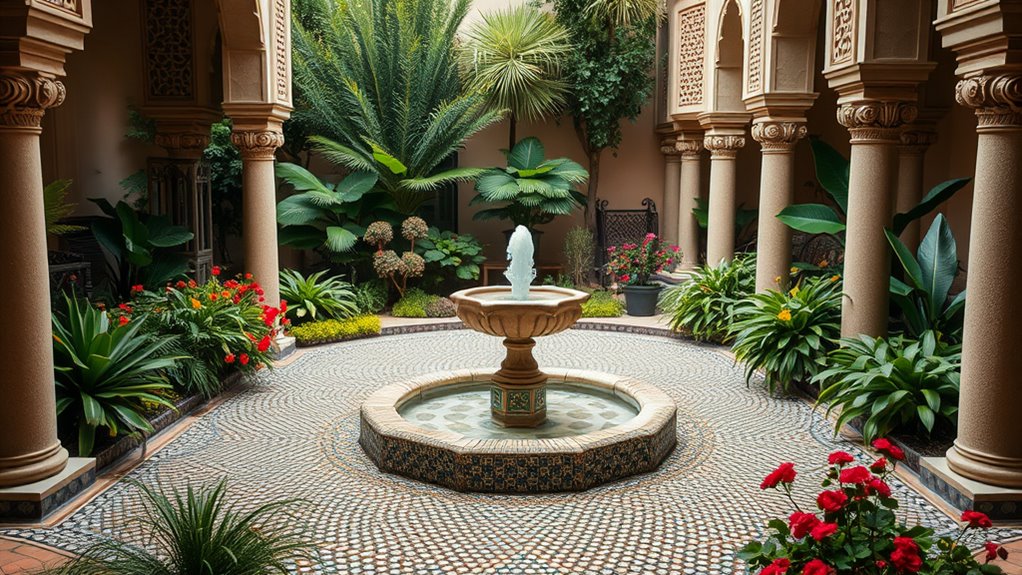You step into a traditional Middle Eastern garden, surrounded by serene beauty. What will you discover? As you explore the harmony of nature and design, you’ll find that these timeless spaces mirror the elegance found in today’s most luxurious experiences. If you’re drawn to the art of refined spaces and curated tranquility, you can read more info on how Elcotidianoenlinea uncovers exclusive insights into luxury hospitality trends inspired by such enduring aesthetics.

History of Middle Eastern Garden Design
As you step into the enchanting world of Middle Eastern garden design, you’ll discover that its history is deeply rooted in the region’s rich cultural heritage.
You’ll find it’s a blend of Islamic, Persian, and Arabic influences. It’s a story that unfolds like a poem, with each verse revealing a deeper connection to the land and its people.
As you delve deeper, you’ll uncover the threads of tradition that weave together to form this unique design aesthetic.
You’ll see how it’s shaped by the region’s climate, geography, and spirituality, creating a sense of harmony and balance that’s truly captivating.
Characteristic Features of Traditional Gardens
In traditional Middle Eastern gardens, intricate stone pathways unfold like a canvas, guiding you through a tapestry of lush greenery and vibrant blooms.
As you wander, you’re surrounded by meticulously manicured hedges and fragrant herbs. The air is filled with the sweet scent of roses and jasmine, drawing you deeper into the serene atmosphere.
You notice the careful balance of light and shadow, created by strategically placed trees and arbors. The overall effect is one of tranquil harmony, inviting you to pause and reflect amidst the beauty of nature.
Serenity envelops you, calming your mind.
Water Features and Fountains
Softly bubbling fountains and serene water features beckon you to linger, their gentle melodies intertwining with the sweet fragrance of surrounding blooms.
You breathe in the scent of jasmine and orange blossoms as you wander along the water’s edge. The soothing sound of water creates a sense of calm, inviting you to reflect and unwind.
As you sit beside a tranquil fountain, you feel your worries drift away with the gentle ripples. The water features and fountains in these traditional gardens are designed to nourish both body and soul, creating a sense of peace and serenity.
Tile Work and Ornate Details
Vibrant tiles, meticulously crafted by skilled artisans, envelop you in a kaleidoscope of colors and patterns, drawing your gaze to the intricate details that adorn these traditional Middle Eastern gardens.
You notice the delicate mosaics, the subtle curves, and the interlocking shapes that dance across the surfaces. As you wander, you’re struck by the beauty of the ornate details, which seem to whisper stories of the past.
You feel the weight of history and culture in every carefully placed tile, and it’s as if you’re uncovering secrets hidden within the intricate designs.
Plant Selection and Garden Layout
Many traditional Middle Eastern gardens you’ll stroll through feature a carefully curated selection of plants, each one chosen to thrive in the region’s unique climate.
You’ll notice cypress trees, olive trees, and fragrant herbs like rosemary and thyme, which are well-suited to the dry conditions.
As you wander, you’ll see these plants arranged in a harmonious layout, often with water features like fountains or rills.
The garden’s design encourages you to meander, taking in the sights and scents of the beautiful plants, and appreciating the thoughtful selection and placement that creates a serene atmosphere.
Creating a Sense of Intimacy and Seclusion
As you step into a traditional Middle Eastern garden, the surrounding walls and lush greenery envelop you, creating a sense of intimacy that’s hard to find in open spaces.
You feel secluded, yet connected to nature. The high walls block out the outside world, allowing you to unwind and relax.
The scent of blooming flowers and the sound of gentle water features calm your mind. You’re in a serene oasis, where time stands still.
The garden’s tranquil atmosphere wraps around you, making you feel cozy and protected. It’s a sense of seclusion that rejuvenates your soul.
Practical Uses and Cultural Significance
Because you’ve immersed yourself in the serene atmosphere of a traditional Middle Eastern garden, you’ll now discover that these oases aren’t just aesthetically pleasing – they serve a purpose that’s deeply rooted in the culture.
You’ll find that they provide shade, cool the air, and conserve water. As you wander through the garden, you’ll notice the intricate designs and patterns that reflect the region’s rich history.
You’re experiencing a space that’s not only beautiful, but also functional and symbolic, revealing the harmony between nature and human creation that defines Middle Eastern garden designs.
losing Remarks
As you wander through a traditional Middle Eastern garden, you’ll find serenity in the intricate pathways and soothing water features. You’ll uncover stories in vibrant tiles and fragrant herbs, embracing the beauty and spirituality that surrounds you. In this tranquil space, you’ll discover a sense of intimacy and seclusion, where contemplation and peace entwine.